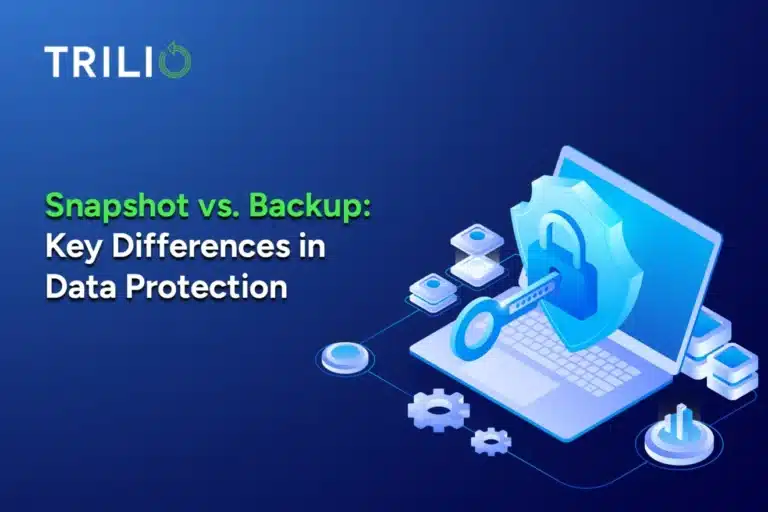By Trilio Content Team | November 7, 2022
Organizations are increasingly deploying multiple Kubernetes clusters to support geographically distributed operations and meet compliance requirements. Instead of managing one or a few large clusters to deploy applications, many DevOps and IT teams are managing thousands of clusters on-prem or in the public cloud.
No matter where your K8s data is hosted, Red Hat Advanced Cluster Management (ACM) helps teams run their operations from anywhere that Red Hat OpenShift runs and manage any Kubernetes cluster in their fleet. But despite the benefits, management of these ‘fleets’ of clusters can become quite complex, requiring a strategic approach to data management and resiliency.
Understanding OpenShift and Resiliency
OpenShift, developed by Red Hat, is a container platform that enables organizations to effectively deploy, manage, and scale applications in containers. In this context, resiliency refers to the ability of applications to remain operational despite challenges and disruptions.
Built on top of Kubernetes, OpenShift provides a platform for container orchestration by incorporating developer and operational tools. It automates tasks involved in deploying and scaling applications making it an appealing option for modern cloud native development. Ensuring resiliency within this environment is crucial to maintaining application availability and functionality in, ideal situations.
The Significance of Being Resilient
Being resilient is extremely important when it comes to any IT infrastructure. It becomes more crucial within the realm of OpenShift. This is because downtime can be quite costly, in a world where applications need to be constantly accessible to users. Resiliency ensures that when there are hardware failures, network problems or other unexpected disruptions services can continue running and data remains easily accessible. Essentially resiliency is the key to maintaining business operations.
In OpenShift environments, where applications are often spread across containers and nodes, incorporating resiliency into the strategy is vital. Without measures in place to promote resiliency an issue in one part of the system could potentially bring down the application resulting in significant disruptions and losses both, in terms of time and money.
Challenges in Building Resilience
Building resilience in OpenShift environments presents challenges. The dynamic nature of containers and the automatic load balancing and scaling provided by OpenShift can make it challenging to implement resilience solutions. When containers have the ability to move between nodes freely and applications can scale up or down based on demand it requires an approach to planning for resilience.
To tackle this, organizations need to consider strategies that are adaptable to this environment. This may involve implementing automated mechanisms, dynamic scaling capabilities, and self-healing mechanisms. While OpenShift itself offers features that aid in achieving resiliency, additional solutions may be necessary to ensure data resiliency through measures, like backup and recovery.
Utilizing Trilio for Enhanced Resilience
With Trilio, organizations have the ability to establish, manage, and execute backup and recovery procedures for applications running on OpenShift. The primary objective is to implement measures that ensure the functioning of your applications even in challenging circumstances.
Trilio empowers you to effortlessly create automated backups, carry out point-in-time recoveries, and capture application snapshots. This not only guarantees the preservation of your data backups but also safeguards the state of your applications, their configurations, and the interconnections between different components. In an era where application and data resilience are negotiable requirements, Trilio serves as an indispensable safety measure.
Important Trilio Features
Trilio has a range of features that make it an excellent resiliency solution, for OpenShift environments:
- Automated Backups: Trilio takes care of the process automatically ensuring that critical data and application state information are regularly saved without any intervention required.
- Point in Time Recovery: In case of data loss or application failure you can restore your system to a point in time minimizing any data loss and reducing downtime.
- Application Aware Snapshots: Trilio understands the characteristics of your applications. Captures snapshots that are context-aware ensuring efficient and accurate recovery.
- Seamless Integration with OpenShift: Trilio is seamlessly designed to work within the OpenShift environment providing administrators and developers with a native experience.
With these combined features Trilio becomes a tool for achieving application and data resiliency, in OpenShift environments.
Building a Resilience Strategy
Developing a strategy for resilience in an OpenShift environment involves steps. It is crucial for organizations to establish a plan that encompasses elements such as backup policies, disaster recovery planning, and rigorous testing.
- Backup Policies: It is essential to create defined policies regarding data and application backups. This should include determining what data needs to be backed up, how frequently backups should be performed, and where these backups are stored.
- Disaster Recovery Planning: Organizations should develop a plan for recovering from failures or disasters. This plan should outline the steps to be taken in failure scenarios and clearly define the roles and responsibilities of each team member involved in the recovery process.
- Testing: Regularly testing your resilience strategy is vital to ensure its effectiveness. This can involve simulating failures or implementing recovery procedures to validate that both your backup systems and recovery plans are reliable.
By having a documented and thoroughly tested resilience strategy, you can have confidence that your OpenShift environment will be able to recover and continue operating even in the face of unexpected disasters or failures.
Best Practices for Resilience
When it comes to achieving success in OpenShift it’s crucial to implement strategies for resilience. Here are some recommended practices to consider:
- Regular Backups: Make sure you have a backup system in place that is scheduled on a regular basis and automated to minimize the chances of human error.
- Monitoring and Alert Systems: Implement monitoring and alert systems that can promptly notify you of any issues enabling faster response times and quicker recovery.
- Recovery Time Objectives (RTO) and Recovery Point Objectives (RPO): Establish goals for RTO and RPO. RTO defines the downtime while RPO determines the maximum allowable data loss. These metrics serve as guidelines for your resilience initiatives.
Comprehensive Documentation: Create documentation outlining your resilience strategy and procedures ensuring that anyone, within your organization can easily understand and follow the plan.
In summary
It is crucial to prioritize the establishment of application and data resiliency, in OpenShift to maintain business operations. Trilio offers automated backups, point-in-time recovery, and application-aware snapshots that are instrumental in achieving resiliency within OpenShift environments. Resilience guarantees that applications and data remain accessible and functional during disruptions making it a critical element in today’s cloud native IT landscape. By adhering to recommended practices and leveraging solutions, like Trilio organizations can ensure their OpenShift environments are well-equipped to overcome any obstacles they may encounter.




